Bond Behavior of Glass Fine Aggregate Reinforcement Concrete after Chloride Erosion under Deicing Salt
Abstract
1. Introduction
2. Experimental Procedure
2.1. Materials
2.2. Items of Investigation
2.2.1. Chloride Erosion Tests
2.2.2. Center Pull-Out Tests
3. Experimental Results and Discussion
3.1. Chloride Erosion Test
Corrosion Rate of Reinforcement
3.2. Center Pull-Out Test
3.2.1. Failure Mode Analysis
3.2.2. Bond-Slip Curve
- (a)
- Test data processing
- (b)
- τ–s curve
3.3. Bond Performance Analysis of GFARC
3.3.1. Ultimate Bond Strength
3.3.2. Peak Slip and Bond Stiffness
3.4. Analysis of the Bond Mechanism of GFARC
4. Conclusions
Author Contributions
Funding
Institutional Review Board Statement
Informed Consent Statement
Data Availability Statement
Conflicts of Interest
Glossary
| ρ | density of the steel bars/% (ρ = 7.78 g/cm3) |
| L | length of the interception segment/mm |
| M | mass of steel bar/Kg |
| S | sectional area/mm2 |
| τ | average bond stress/MPa, |
| P | bond force/kN |
| d | reinforcement diameter/mm |
| anchorage length/mm | |
| P1 | tensile force at the end of the loading |
| Es | elastic modulus of reinforcement |
| As | cross-sectional area of the reinforcement |
| LS | original length of the CD section |
References
- Khan, N.N.; Saha, A.K.; Sarker, P.K. Reuse of waste glass as a supplementary binder and aggregate for sustainable cement-based construction materials: A review. J. Build. Eng. 2019, 28, 101052. [Google Scholar] [CrossRef]
- Topcu, I.B.; Canbaz, M. Properties of concrete containing waste glass. Cem. Concr. Res. 2004, 34, 267–274. [Google Scholar] [CrossRef]
- Khmiri, A.; Chaabouni, M.; Samet, B. Chemical behaviour of ground waste glass when used as partial cement replacement in mortars. Constr. Build. Mater. 2013, 44, 74–80. [Google Scholar] [CrossRef]
- Kim, I.S.; Choi, S.Y.; Yang, E.I. Evaluation of durability of concrete substituted heavyweight waste glass as fine aggregate. Constr. Build. Mater. 2018, 184, 269–277. [Google Scholar] [CrossRef]
- Shao, Y.; Lefort, T.; Moras, S.; Rodriguez, D. Studies on concrete containing ground waste glass. Cem. Concr. Res. 2000, 30, 91–100. [Google Scholar] [CrossRef]
- Dyer, T.D.; Dhir, R.K. Chemical Reactions of Glass Cullet Used as Cement Component. J. Mater. Civ. Eng. 2001, 13, 412–417. [Google Scholar] [CrossRef]
- Shayan, A.; Xu, A. Performance of Glass Powder as a Pozzolanic Material in Concrete. Cem. Concr. Res. 2002, 36, 457–468. [Google Scholar] [CrossRef]
- Saha, A.K.; Khan, M.; Sarker, P.K.; Shaikh, F.A.; Pramanik, A. The ASR mechanism of reactive aggregates in concrete and its mitigation by fly ash: A critical review. Constr. Build. Mater. 2018, 171, 743–758. [Google Scholar] [CrossRef]
- Du, H.; Tan, K.H. Waste Glass Powder as Cement Replacement in Concrete. J. Adv. Concr. Technol. 2014, 12, 468–477. [Google Scholar] [CrossRef]
- Wang, F.; Wu, X.; Guo, C.; Song, W. Experimental Study on Bond Strength of Deformed Steel Bars in Recycled Glass Aggregate Concrete. KSCE J. Civ. Eng. 2018, 9, 3409–3418. [Google Scholar] [CrossRef]
- Taha, B.; Nounu, G. Utilizing Waste Recycled Glass as Sand/Cement Replacement in Concrete. J. Mater. Civ. Eng. 2009, 21, 709–721. [Google Scholar] [CrossRef]
- Du, H.; Tan, K.H. Concrete with Recycled Glass as Fine Aggregates. ACI Mater. J. 2014, 111, 47–58. [Google Scholar]
- Cota, F.P.; Melo, C.C.D.; Panzera, T.H.; Araújo, A.G.; Borges, P.H.R.; Scarpa, F. Mechanical properties and ASR evaluation of concrete tiles with waste glass aggregate. Sustain. Cities Soc. 2015, 16, 49–56. [Google Scholar] [CrossRef]
- Ababneh, A.; Benboudjema, F.; Xi, Y. Chloride Penetration in Nonsaturated Concrete. J. Mater. Civ. Eng. 2003, 15, 183–191. [Google Scholar] [CrossRef]
- Zhu, W.; François, R. Experimental investigation of the relationships between residual cross-section shapes and the ductility of corroded bars. Constr. Build. Mater. 2014, 69, 335–345. [Google Scholar] [CrossRef]
- Lee, H.-S.; Noguchi, T.; Tomosawa, F. Evaluation of the bond properties between concrete and reinforcement as a function of the degree of reinforcement corrosion. Cem. Concr. Res. 2002, 32, 1313–1318. [Google Scholar] [CrossRef]
- Tondolo, F. Bond behavior with reinforcement corrosion. Constr. Build. Mater. 2015, 93, 926–932. [Google Scholar] [CrossRef]
- Coccia, S.; Imperatore, S.; Rinaldi, Z. Influence of corrosion on the bond strength of steel rebars in concrete. Mater. Struct. 2016, 49, 537–551. [Google Scholar] [CrossRef]
- Auyeung, Y.B.; Balaguru, P.; Chung, L. Bond behavior of corroded reinforcement bars. ACI Mater. J. 2000, 97, 214–220. [Google Scholar]
- Fang, C.; Lundgren, K.; Plos, M.; Gylltoft, K. Bond behavior of corroded reinforcing steel bars in concrete. Cem. Concr. Res. 2006, 36, 1931–1938. [Google Scholar] [CrossRef]
- Alhawat, M.; Ashour, A. Bond strength between corroded steel reinforcement and recycled aggregate concrete. Structures 2019, 19, 369–385. [Google Scholar] [CrossRef]
- Wang, Q.; Dai, R.; Wang, S.; Wang, Y. Prediction Algorithm and Interpretation for Autogenous Shrinkage of Concrete Based on Machine Learning. J. Shenyang Jianzhu Univ. 2023, 39, 1050–1057. [Google Scholar]
- IS 8112:1989; Specification for 43 Grade Ordinary Portland Cement. Bureau of Indian Standards (BIS): New Delhi, India, 1989.
- Wang, F.; Guo, H.; Lin, Z.; Zhao, H. Bond Properties of Glass Aggregate–Reinforced Concrete after Freeze–Thaw Cycles. J. Cold Reg. Eng. 2024, 38, 04023025. [Google Scholar] [CrossRef]
- Xu, Y. Experimental Study on Bond Anchorage Behavior of Deformed Bar and Concrete. Ph.D. Thesis, Tsinghua University, Beijing, China, 1990. (In Chinese). [Google Scholar]
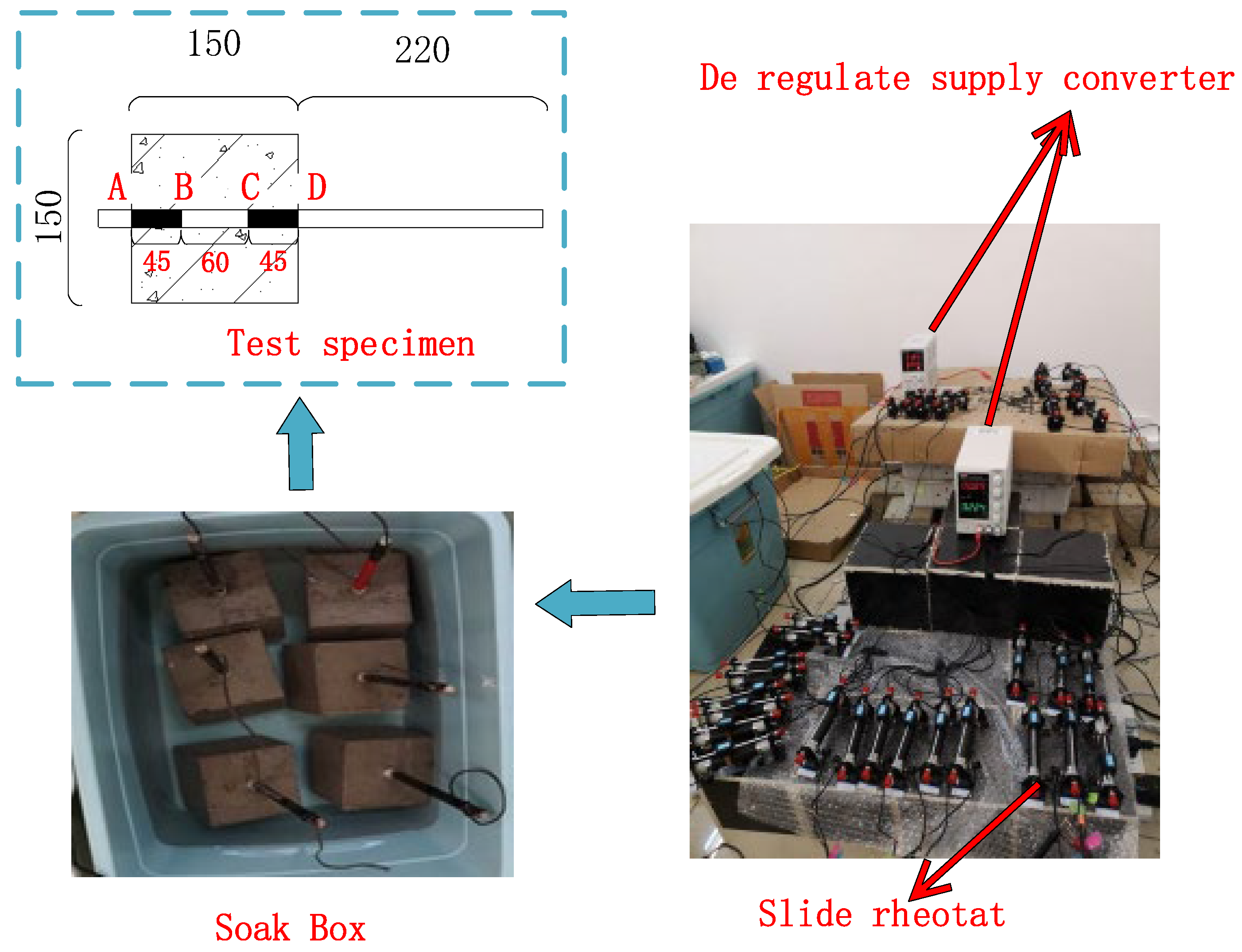
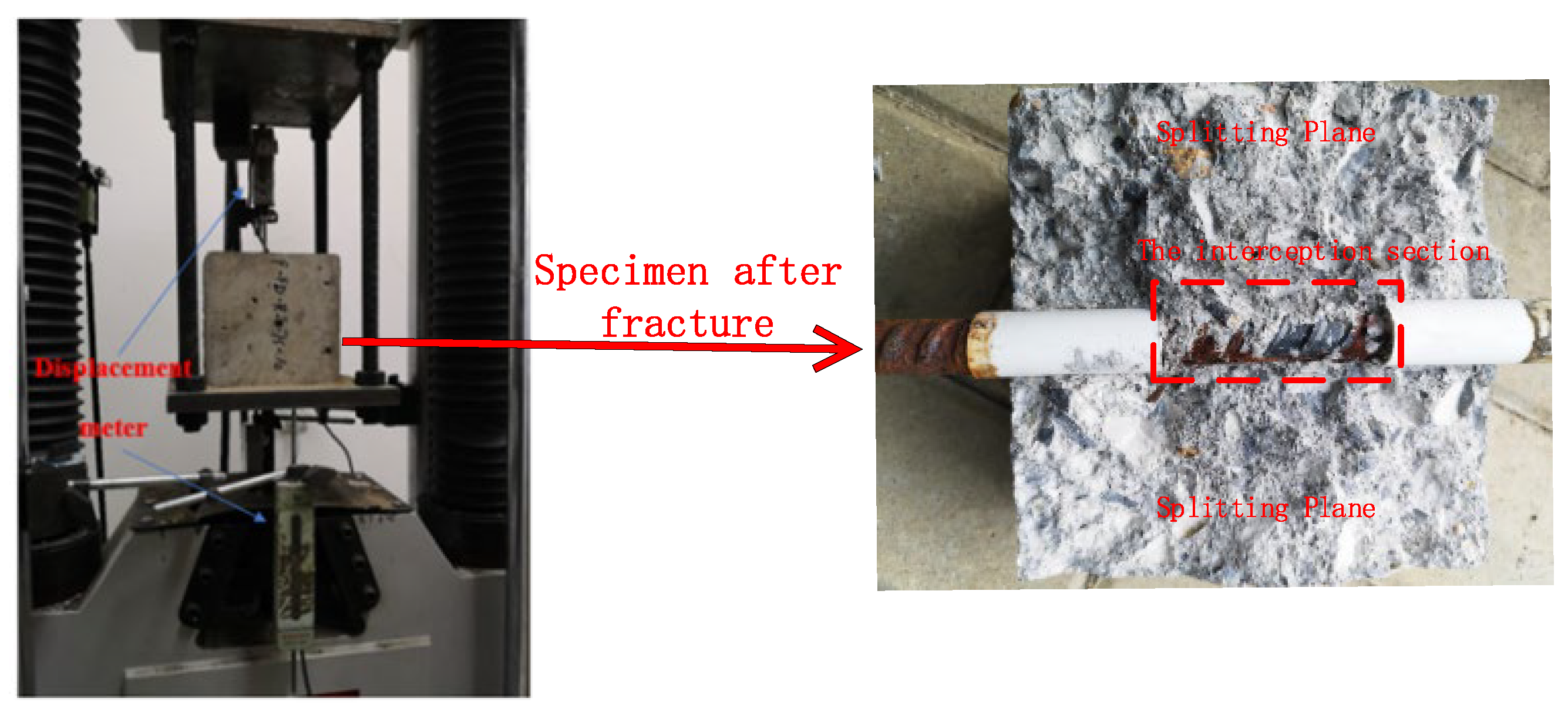

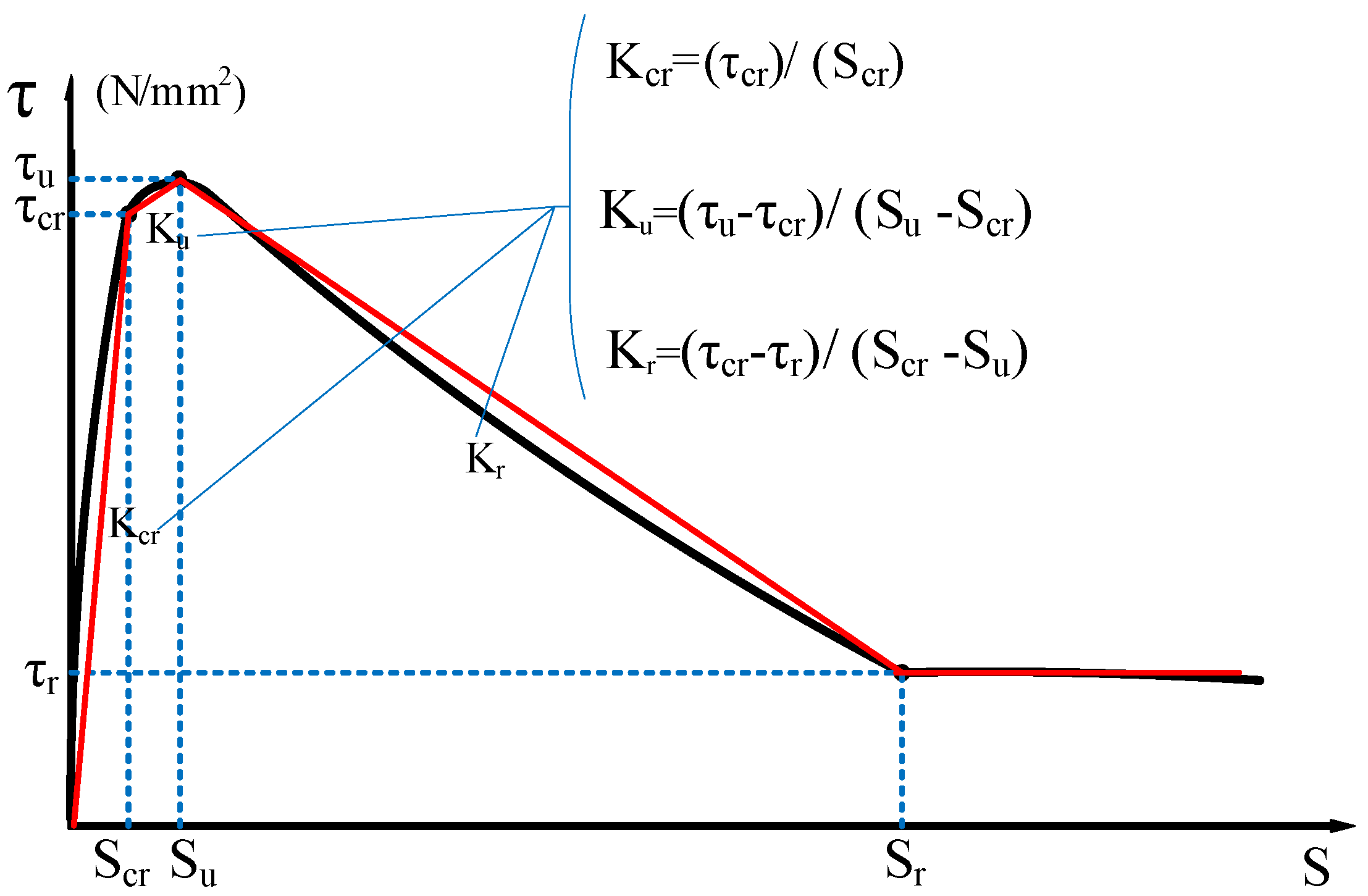
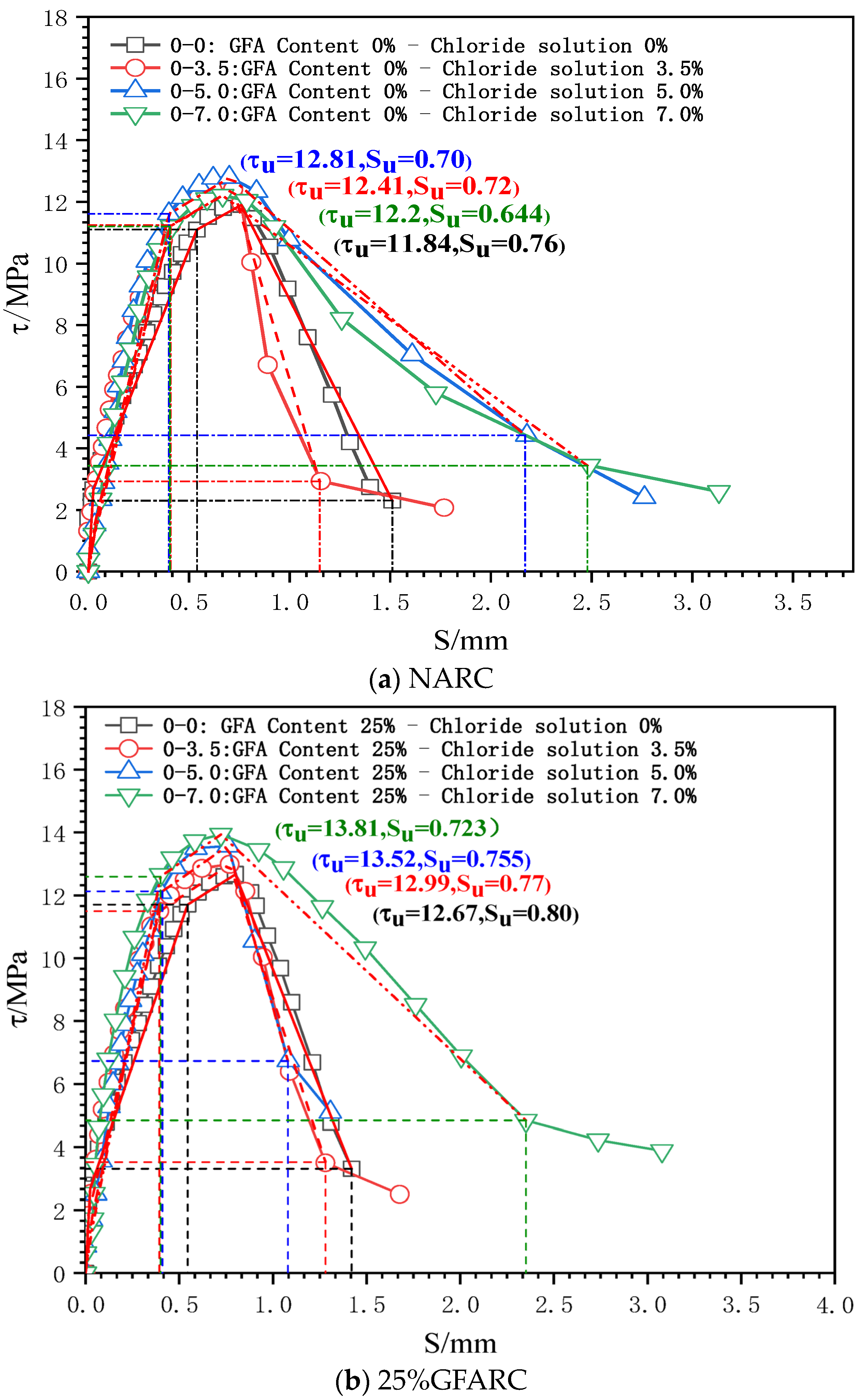
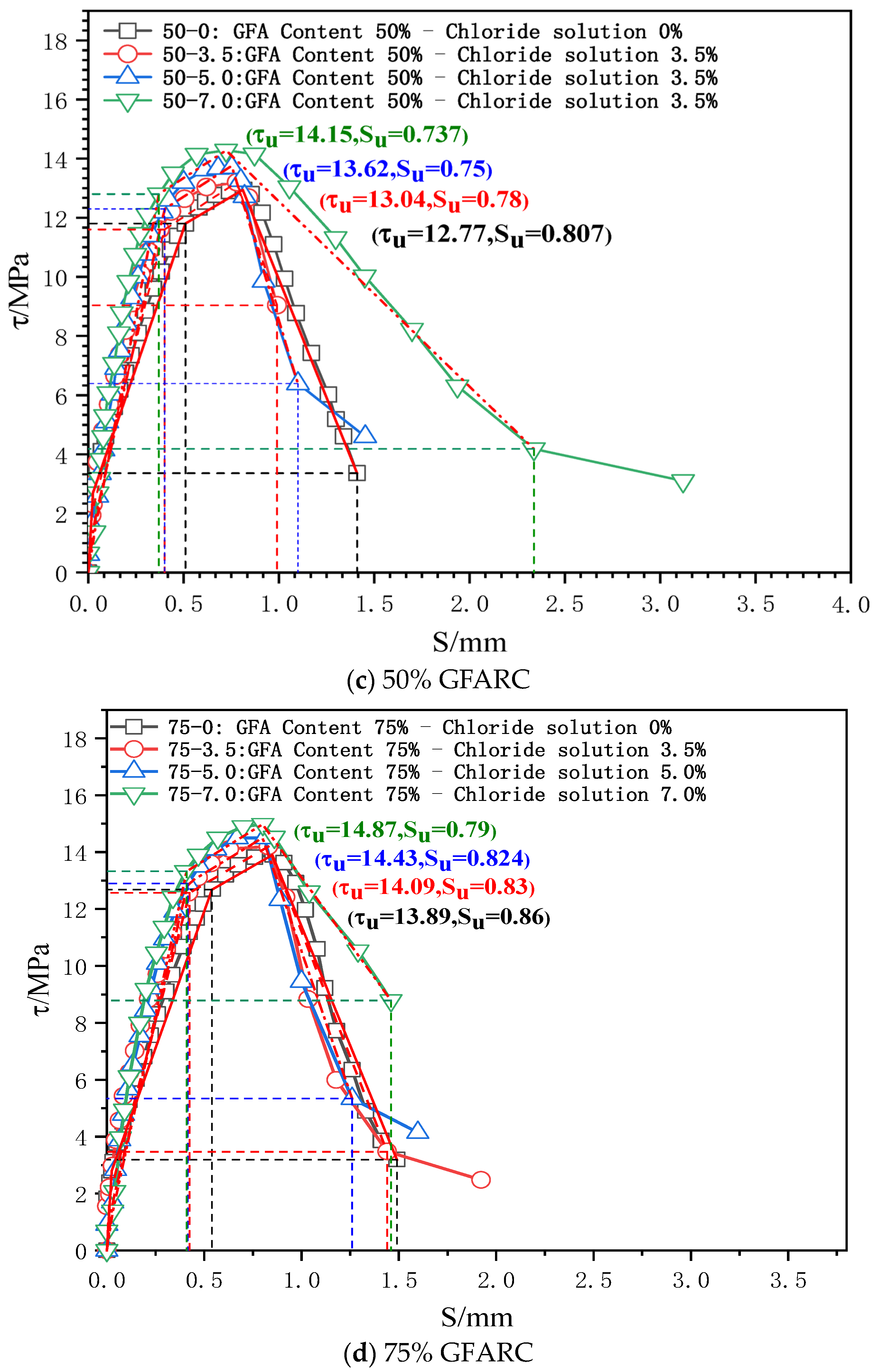
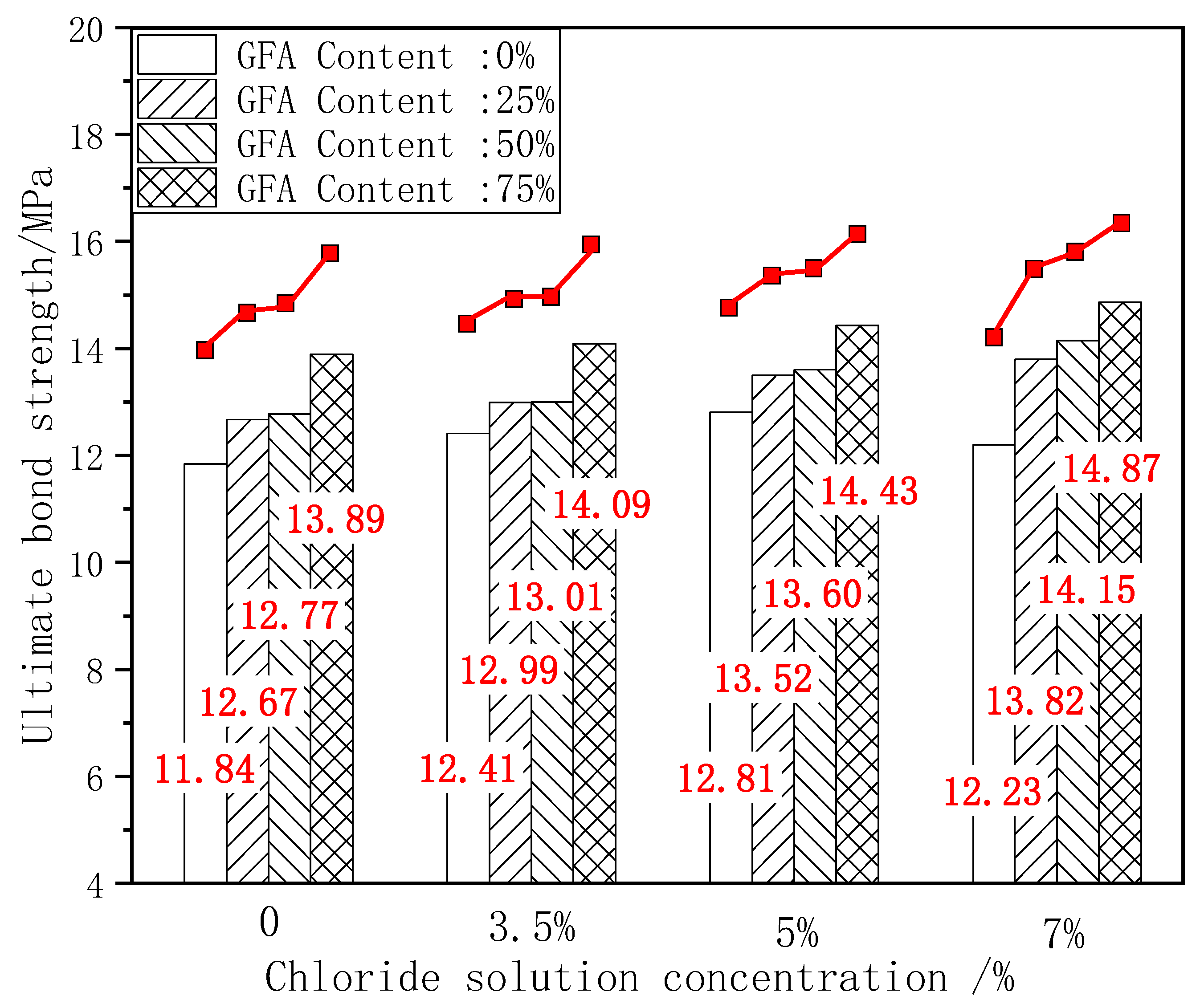

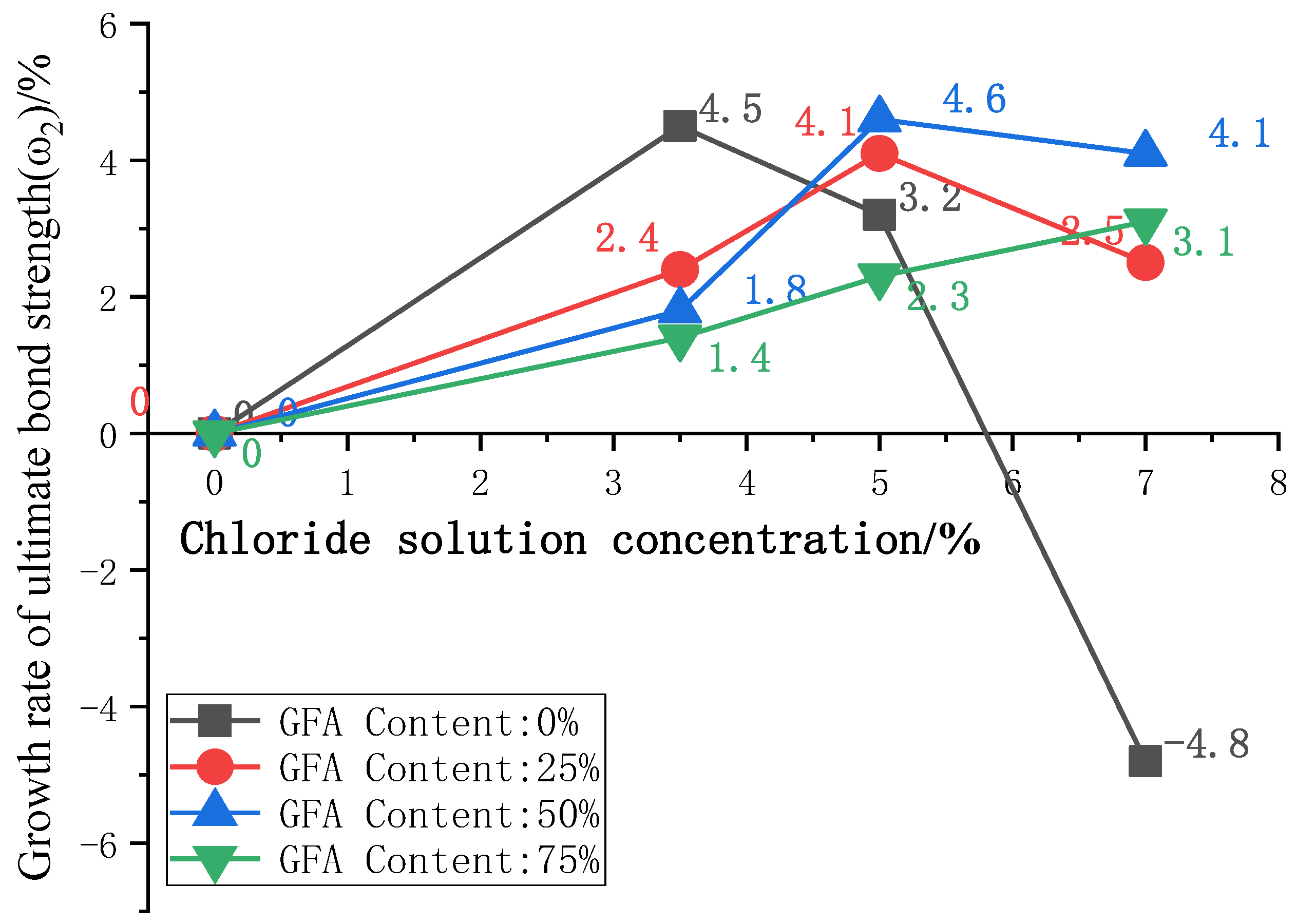

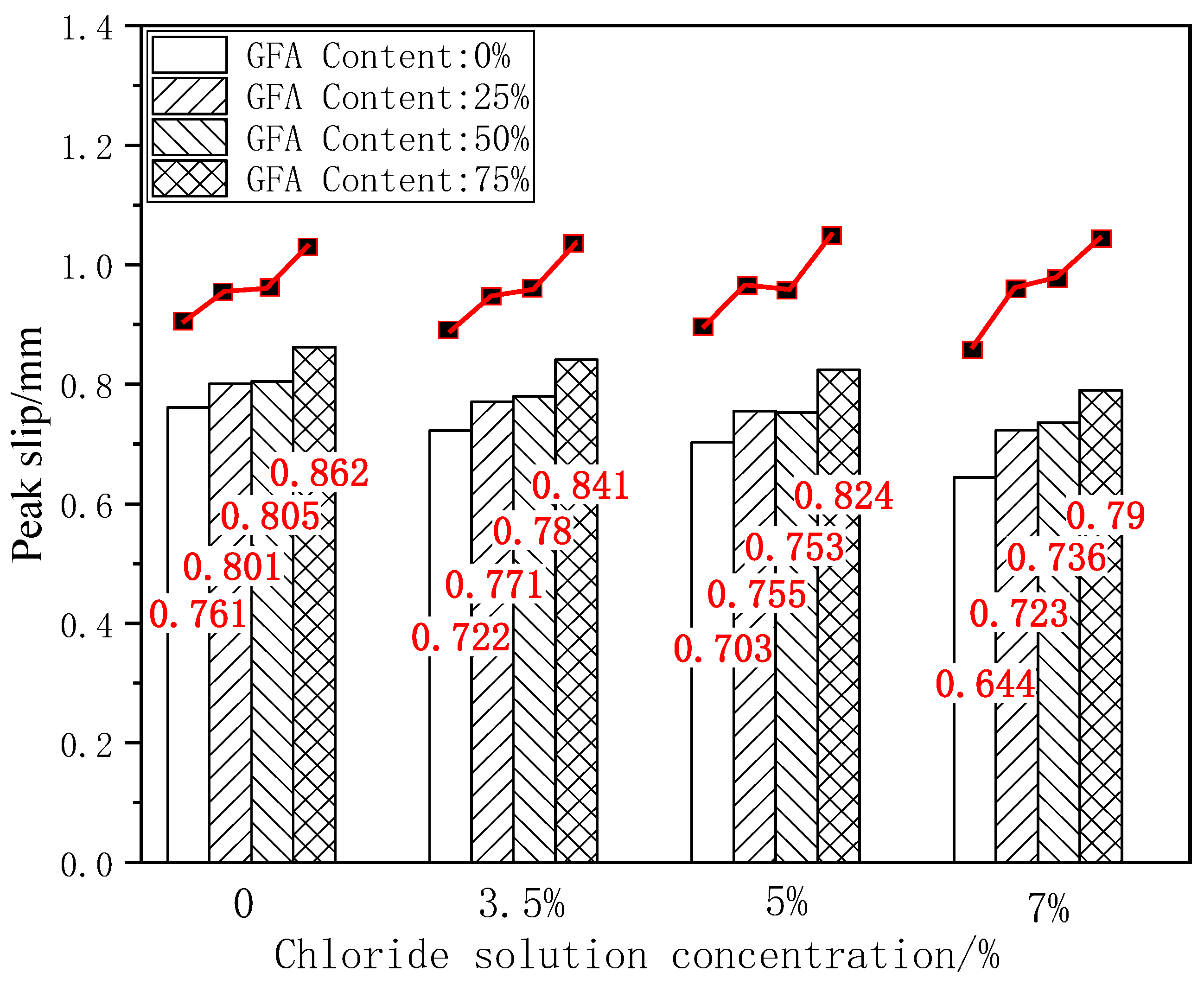
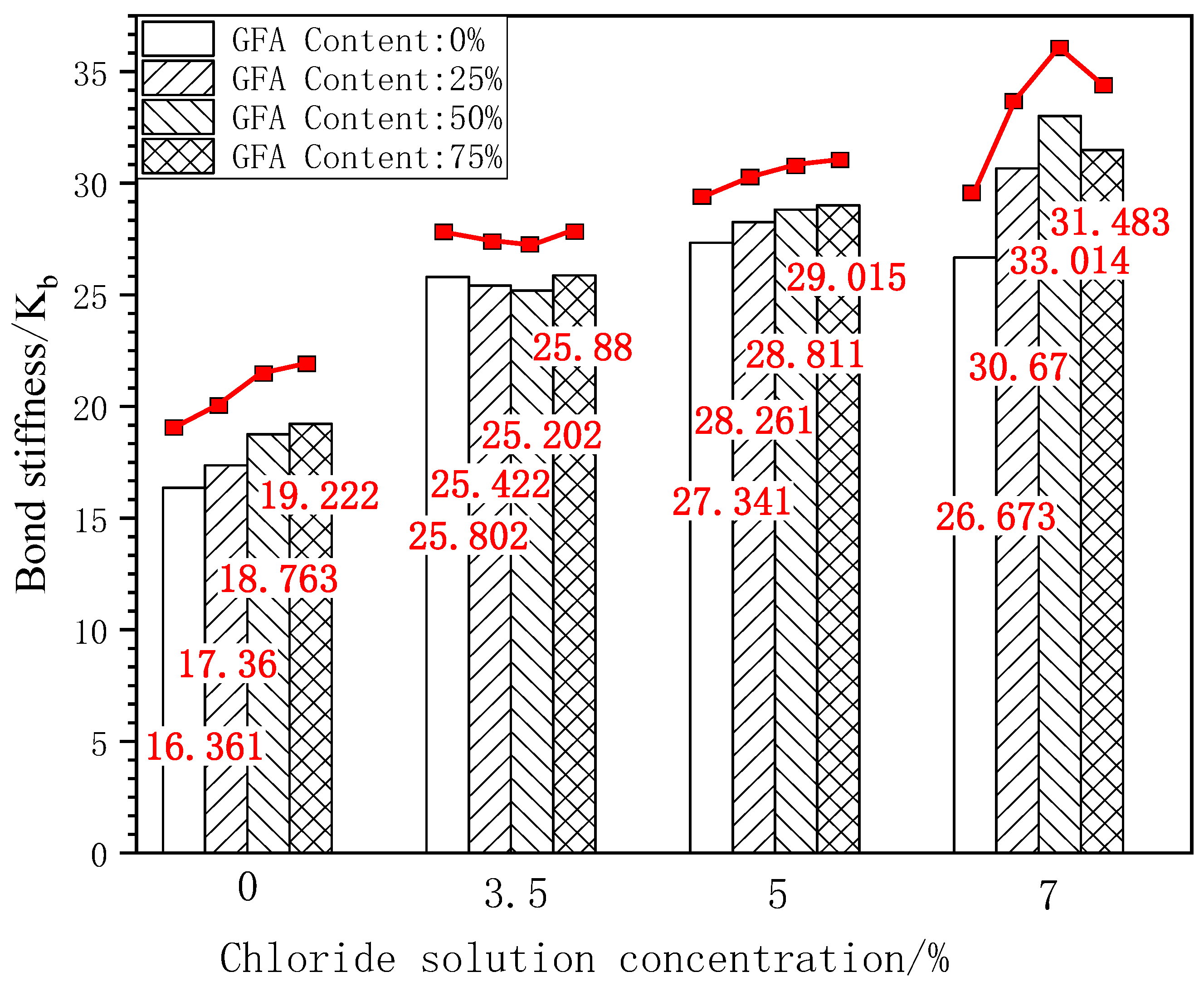

| GFA Content (%) | Cement (kg/m3) | Natural Sand (kg/m3) | Gravel (kg/m3) | Water (kg/m3) | Glass Fine Aggregate (kg/m)3 |
|---|---|---|---|---|---|
| 0 | 335 | 685 | 1200 | 180 | 0 |
| 25 | 335 | 513.75 | 1200 | 180 | 171.25 |
| 50 | 335 | 342.5 | 1200 | 180 | 342.5 |
| 75 | 335 | 171.25 | 1200 | 180 | 513.75 |
| Glass Fine Aggregate Content | ||||
|---|---|---|---|---|
| Chloride Solution Concentration | 0% | 25% | 50% | 75% |
| 3.5% | Splitting failure | Splitting failure | Splitting failure | Splitting failure |
| 5% | Pull-out failure | Split-pull-out | Split-pull-out | Splitting failure |
| 7% | Pull-out failure | Pull-out failure | Split-pull-out | Splitting failure |
Disclaimer/Publisher’s Note: The statements, opinions and data contained in all publications are solely those of the individual author(s) and contributor(s) and not of MDPI and/or the editor(s). MDPI and/or the editor(s) disclaim responsibility for any injury to people or property resulting from any ideas, methods, instructions or products referred to in the content. |
© 2024 by the authors. Licensee MDPI, Basel, Switzerland. This article is an open access article distributed under the terms and conditions of the Creative Commons Attribution (CC BY) license (https://creativecommons.org/licenses/by/4.0/).
Share and Cite
Liu, J.; Guo, H.; Wang, F.; Li, Y. Bond Behavior of Glass Fine Aggregate Reinforcement Concrete after Chloride Erosion under Deicing Salt. Coatings 2024, 14, 444. https://doi.org/10.3390/coatings14040444
Liu J, Guo H, Wang F, Li Y. Bond Behavior of Glass Fine Aggregate Reinforcement Concrete after Chloride Erosion under Deicing Salt. Coatings. 2024; 14(4):444. https://doi.org/10.3390/coatings14040444
Chicago/Turabian StyleLiu, Jian, Hao Guo, Fengchi Wang, and Yanfeng Li. 2024. "Bond Behavior of Glass Fine Aggregate Reinforcement Concrete after Chloride Erosion under Deicing Salt" Coatings 14, no. 4: 444. https://doi.org/10.3390/coatings14040444
APA StyleLiu, J., Guo, H., Wang, F., & Li, Y. (2024). Bond Behavior of Glass Fine Aggregate Reinforcement Concrete after Chloride Erosion under Deicing Salt. Coatings, 14(4), 444. https://doi.org/10.3390/coatings14040444






